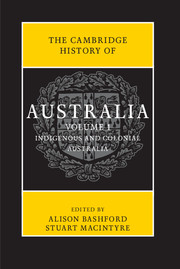Book contents
- Frontmatter
- Contents
- Abbreviations
- List of maps
- List of figures
- List of tables
- Notes on contributors
- Map
- Preface
- Introduction
- PART I
- PART II
- 11 Environmental transformations
- 12 Population and health
- 13 The economy
- 14 Indigenous and settler relations
- 15 Education
- 16 Law and regulation
- 17 Religion
- 18 Colonial science and technology
- 19 Gender and colonial society
- 20 Art and literature: a cosmopolitan culture
- 21 Empire: Australia and ‘Greater Britain’, 1788–1901
- 22 Colonial Australia and the Asia-Pacific region
- 23 The Australian colonies in a maritime world
- Further reading
- Chronology
- Index
- Frontmatter
- Contents
- Abbreviations
- List of maps
- List of figures
- List of tables
- Notes on contributors
- Map
- Preface
- Introduction
- PART I
- PART II
- Further reading
- Chronology
- Index
22 - Colonial Australia and the Asia-Pacific region
from PART II
Published online by Cambridge University Press: 05 November 2013
- Frontmatter
- Contents
- Abbreviations
- List of maps
- List of figures
- List of tables
- Notes on contributors
- Map
- Preface
- Introduction
- PART I
- PART II
- 11 Environmental transformations
- 12 Population and health
- 13 The economy
- 14 Indigenous and settler relations
- 15 Education
- 16 Law and regulation
- 17 Religion
- 18 Colonial science and technology
- 19 Gender and colonial society
- 20 Art and literature: a cosmopolitan culture
- 21 Empire: Australia and ‘Greater Britain’, 1788–1901
- 22 Colonial Australia and the Asia-Pacific region
- 23 The Australian colonies in a maritime world
- Further reading
- Chronology
- Index
- Frontmatter
- Contents
- Abbreviations
- List of maps
- List of figures
- List of tables
- Notes on contributors
- Map
- Preface
- Introduction
- PART I
- PART II
- Further reading
- Chronology
- Index
Summary
A regional perspective
The history of Australia has traditionally been written as though its geographical position in the south-west Pacific, at the edge of Asia and adjacent to Oceania, were largely irrelevant to its historical experience and formation as a nation, as though its history and geography were somehow at odds. In standard national histories, Asia and the Pacific might receive only a paragraph or two and barely rate a mention in the index. Beset by the ‘tyranny of distance’, located thousands of kilometres from the metropolitan centres of Europe, Australia and New Zealand have been conceptualised as isolated British outposts, ‘in most senses’, in Geoffrey Blainey's words, ‘imitations of Britain’.
The new imperial history together with recent scholarship on the ‘British world’ has often been motivated by a desire to locate Australia in a transnational context. Yet because of its ‘insiderism’ (in the historian Antoinette Burton's phrase) it has frequently reinforced an understanding of an Australian history as bounded by ‘Britishness’, isolated from the countries and cultures of its own region and the non-British world. Recent promotion of the salience of ‘British race patriotism’ in Australia has, moreover, obscured the strong transpacific identification among radical liberals of the late nineteenth century with the United States. The affective solidarity with the white republic found expression in the popular support offered to the Americans in the Spanish–American war and the welcome to the United States naval fleet in 1908, a solidarity encouraged on both sides of the Pacific by Prime Minister Alfred Deakin and President Theodore Roosevelt.
In an essay calling for British imperial historiography to orient itself better to world history, Antoinette Burton has recommended that historians adopt ‘an enlarged spatial optic’ that recognises the ‘multiple imperial presences’ across much of the world and the ways in which the British Empire was shaped in dynamic tension with Asian and other empires.
- Type
- Chapter
- Information
- The Cambridge History of Australia , pp. 535 - 559Publisher: Cambridge University PressPrint publication year: 2013
- 6
- Cited by



